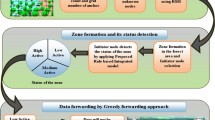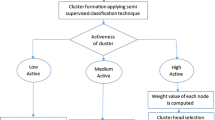Abstract
Automatically increases the danger of starting fires due to global warming, and the number of forest fires is growing. Natural disasters are a regular occurrence in which both living and nonliving things in the environment are affected. Humans, on the other hand, can anticipate disaster and take significant measures to avoid it. There are a variety of technologies that can predict abnormalities or changes in exposed open areas. As autonomous sensors, Wireless sensors and Actuator Networks are used to monitor physical and environmental conditions. Though WSANs applications are being implemented with various location prediction techniques, there are still issues predicting more accurate data. The work mainly aims at identifying the abnormalities in certain areas, given location and distance information to wireless sensor networks. The proposed system includes the phases such as network construction, cluster head (CH) node selection, forest fire prediction, and data transmission. In the network construction, sensor nodes and actuator nodes are associated with sending and receiving the packets.The energy model and mobility model are built to provide efficient packet transmission over WSAN. Then the improved firefly algorithm (IFFA) is designed to select the best CH node depending on better energy utilization, delay, and lifetime between sensor nodes. Enhanced nearest neighbor interpolation with semi-supervised algorithm (ENNISSA) ENNISSA is proposed for a better forest fire prediction model using nearest neighbor interpolation (NNI) method and support vector machine (SVM) & K-means clustering (KMC) algorithm. To predict the oddity, the temperature, positions of heat sources, and pressure around that location are considered for retrieving optimized data using interpolation techniques.The semi-supervised classifier [high active (HA), medium active (MA), and low active (LA)] is presented to resolve this issue by separating the forest area into various zones. The significance of the work is to predict more accurate information of anomalies in uncovered regions. As a result, the suggested ENNISSA method is superior to existing techniques for energy consumption, throughput, end-to-end delay, network lifespan.













Similar content being viewed by others
References
Adams, M. A., Shadmanroodposhti, M., & Neumann, M. (2020). Causes and consequences of Eastern Australia’s 2019–20 season of mega-fires: A broader perspective. Global change biology, 26(7), 3756–3758.
Chen, J., et al. (2010). Distributed collaborative control for industrial automation with wireless sensor and actuator networks. IEEE Transactions on Industrial Electronics, 57(12), 4219–4230.
Feng, J., Shi, X., & Zhang, J. (2018). Dynamic cluster heads selection and data aggregation for efficient target monitoring and tracking in wireless sensor networks. International Journal of Distributed Sensor Networks, 14(6), 1550147718783179.
Cota-Ruiz, J., et al. (2016). A recursive shortest path routing algorithm with application for wireless sensor network localization. IEEE Sensors Journal, 16(11), 4631–4637.
Xing, Y., Song, Q., & Cheng, G. (2019). Benefit of interpolation in nearest neighbor algorithms. arXiv preprint arXiv:1909.11720 (2019).
Kułakowski, P., Calle, E., & Marzo, J. L. (2013). Performance study of wireless sensor and actuator networks in forest fire scenarios. International Journal of Communication Systems, 26(4), 515–529.
Lozano, C., & Rodriguez, O. (2011). Design of forest fire early detection system using wireless sensor networks. Electronics and Electrical Engineering, 3(2), 402–405.
Mosavvar, I., & Ghaffari, A. (2019). Data aggregation in wireless sensor networks using firefly algorithm. Wireless Personal Communications, 104(1), 307–324.
Samara, G., & Aljaidi, M. (2019). Efficient energy, cost reduction, and QoS based routing protocol for wireless sensor networks. arXiv preprint arXiv:1903.09636
Ali, A., et al. (2016). Location prediction optimisation in WSNs using Kriging interpolation. IET Wireless Sensor Systems, 6(3), 74–81.
Benzekri, W., et al. (2020). Early forest fire detection system using wireless sensor network and deep learning. International Journal of Advanced Computer Science and Applications, 11(5), 496–503.
Zhu, H., Gao, D., & Zhang, S. (2019). A perceptron algorithm for forest fire prediction based on wireless sensor networks. Journal on Internet of Things, 1(1), 25.
Guleria, K., Verma, A. K., Goyal, N., Sharma, A. K., Benslimane, A., & Singh, A. (2021). An enhanced energy proficient clustering (EEPC) algorithm for relay selection in heterogeneous WSNs. Ad Hoc Networks, 116, 102473.
Fortino, G., et al. (2012). A flexible building management framework based on wireless sensor and actuator networks. Journal of Network and Computer Applications, 35(6), 1934–1952.
Prakash, S. S., & Reddy, K. S. R. (2014). Firefly inspired energy aware cluster based tree formation in WSN. In 2014 2nd international conference on information and communication technology (ICoICT) (pp. 356-360). IEEE
Pitchaimanickam, B., & Murugaboopathi, G. (2020). A hybrid firefly algorithm with particle swarm optimization for energy efficient optimal cluster head selection in wireless sensor networks. Neural Computing and Applications, 32(12), 7709–7723.
Hariyawan, M. Y., Gunawan, A., & Putra, E. H. (2013). Wireless sensor network for forest fire detection. Telkomnika, 11(3), 563.
Park, G. Y., Kim, H., Jeong, H. W., & Youn, H. Y. (2013). A novel cluster head selection method based on K-means algorithm for energy efficient wireless sensor network. In 2013 27th international conference on advanced information networking and applications workshops (pp. 910–915). IEEE
Belkin, M., Rakhlin, A., & Tsybakov, A. B. (2019). Does data interpolation contradict statistical optimality?. In The 22nd International Conference on Artificial Intelligence and Statistics (pp. 1611–1619). PMLR
Tian, L., Xie, D. L., Ren, B., Zhang, L., & Cheng, S. D. (2007). Routing void problem of greedy forwarding strategy in wireless sensor networks. Journal of Electronics & Information Technology, 29(12), 2996–3000.
Author information
Authors and Affiliations
Corresponding author
Additional information
Publisher's Note
Springer Nature remains neutral with regard to jurisdictional claims in published maps and institutional affiliations.
Rights and permissions
Springer Nature or its licensor holds exclusive rights to this article under a publishing agreement with the author(s) or other rightsholder(s); author self-archiving of the accepted manuscript version of this article is solely governed by the terms of such publishing agreement and applicable law.
About this article
Cite this article
Ananthi, J., Sengottaiyan, N. & Anbukaruppusamy, S. Enhanced interpolation with semi-supervised algorithm and greedy forwarding technique for forest fire prediction over wireless sensor and actuator networks. Wireless Netw 28, 3577–3592 (2022). https://doi.org/10.1007/s11276-022-03072-z
Accepted:
Published:
Issue Date:
DOI: https://doi.org/10.1007/s11276-022-03072-z




